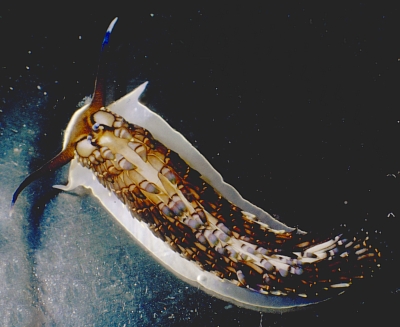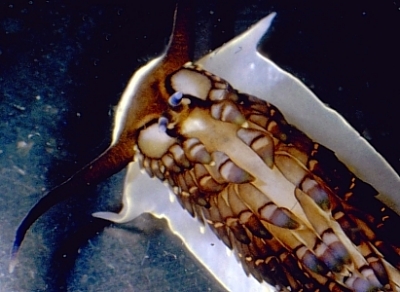

Cerberilla africana
Eliot, 1903
Order: NUDIBRANCHIA
Suborder: AEOLIDINA
Family: Aeolidiidae
DISTRIBUTION
Known from Zanzibar and Dar es Salaam, Tanzania, and northeastern South Africa.
PHOTO
Locality: Fungu Yasin Is., off Kunduchi Bch, Dar es Salaam, Tanzania. 20 July 1973. Photo: Bill Rudman.
Typical species of Cerberilla with a very wide foot, at least twice the width of the body. The cerata are arranged in crowded rows, the cerata greatly increasing in length toward the posterior end of the body. The oral tentacles are long and tentacular and the smooth rhinophores are extremely short.
The colour is known from only two specimens, one described by Eliot (1903) from Zanzibar, and the animal photographed here from nearby Dar es Salaam. The body is translucent white with a brownish dusting over the head and up the oral tentacles where it merges into a blue band and a translucent white tip. The rhinophores are translucent white with a blue band, and on the outside of each rhinophore, there is a brown ring on the head surrounding a large white patch. The ceratal colour changes depending on the size and position of each ceras but the following succession of colour bands up the cerata is fairly uniform, except the width of each band can chnage. The basal band ranges from whitish grey to green or dark brown, and above this is a thin band of dark brown or black. Above this is a thin white band which can be bright yellow or brownish orange in the longer cerata. Above this the cerata are blue, the colour varying from a pale greyish blue to a bright blue.
The photos from South Africa [message #20692] are almost certainly this species. Another species from the western Pacific, C. affinis, is possibly the same species, but we know too little about colour variability at present to be sure.
-
Eliot, C.N.E (1903) On some nudibranchs from East Africa and Zanzibar, Part II. Proceedings of the Zoological Society of London, 1: 250-257.
Rudman, W.B., 2007 (September 11) Cerberilla africana Eliot, 1903. [In] Sea Slug Forum. Australian Museum, Sydney. Available from http://www.seaslugforum.net/find/cerbafri
Related messages
Cerberilla africana from Mozambique
January 9, 2009
From: Valda Fraser


Dear Bill
I found this nudibranch in an estuary. Please help to identify it.
Locality: Pomene, 3m, Mozambique, Indian, 17 December 2008, Estuary. Length: 30mm. Photographer: Valda Fraser.
Best wishes
Valda
valdafraser@mweb.co.za
Fraser, V.J., 2009 (Jan 9) Cerberilla africana from Mozambique. [Message in] Sea Slug Forum. Australian Museum, Sydney. Available from http://www.seaslugforum.net/find/22141
Dear Valda,
This is what I am identifying as Cerberilla africana which Eliot described from Zanzibar, but as I mention in an earlier message [#20692] it could well be the some as Bergh's Fenrisia moebii from Mauritius.
Species of Cerberilla spend much of their time through sandy and muddy substrates, and those we have information on, feed on burrowing sea anemones, or at least anemones which can anchor themselves in soft sediments. I have included a couple of close-ups of your photo to show how the colour pattern on the cerata can change within a lateral row, and also from one end of the animal to the other. I am pretty sure Fenrisia moebii is the same species, but as I show in the earlier message, Bergh only illustrated on ceras.
Best wishes,
Bill Rudman
Re: Cerberilla africana ? from South Africa
September 12, 2007
From: Kathe R. Jensen
Concerning message #20692:
Dear Bill,
This is just correct an often repeated mistake. Bergh's paper from 1888 comprise species collected from Mauritius and surrounding small islands. One of these islands is named Ile de Fouquet (I am not sure about the spelling, and I don't have Bergh's paper at home). The mistake can probably be traced to Index Nudibranchia by Henry Russell, in which the name of this island has mistakenly been identified as the popular tourist resort island Phuket in Thailand. However, the correct type locality is near Mauritius.
Best wishes,
Kathe
krjensen@snm.ku.dk
Jensen, K.R., 2007 (Sep 12) Re: Cerberilla africana ? from South Africa. [Message in] Sea Slug Forum. Australian Museum, Sydney. Available from http://www.seaslugforum.net/find/20707Dear Kathe,
Thanks for that. Like you, I didn't have Bergh at home when I wrote that comment and relied on Index Nudibranchia to check the reference. I must say I was puzzled at 'Thailand' because I thought all the animals on the Plate were from Mauritius. Next time I should go with my instincts. For those of you who haven't yet read my comment on message #20692 I said that C. moebii was from Thailand. I have corrected my comment from 'Thailand' to 'Mauritius' so the mistake is not perpetuated.
Best wishes,
Bill Rudman
Cerberilla africana from Dar es Salaam, Tanzania
September 12, 2007
From: Bill Rudman


To complement Colin Ogden's message [#20692], here are some photos of an animal whiich I collected and photographed in Dar es Salaam, Tanzania, and which I identified as Cerberilla africana. Previously it was known from the single specimen described by Eliot from Zanzibar.
Locality: Fungu Yasin Is., off Kunduchi Bch, Dar es Salaam, Tanzania. 20 July 1973. Photo: Bill Rudman.
The colour is known from only these two specimens. The body is translucent white with a brownish dusting over the head and up the oral tentacles where it merges into a blue band and a translucent white tip. The rhinophores are translucent white with a blue band, and on the outside of each rhinophore, there is a brown ring on the head surrounding a large white patch. The ceratal colour changes depending on the size and position of each ceras but the following succession of colour bands up the cerata is fairly uniform, except the width of each band can chnage. The basal band ranges from whitish grey to green or dark brown, and above this is a thin band of dark brown or black. Above this is a thin white band which can be bright yellow or brownish orange in the longer cerata. Above this the cerata are blue, the colour varying from a pale greyish blue to a bright blue.
The photos from South Africa [message #20692] are almost certainly this species. Another species from the western Pacific, C. affinis, is possibly the same species, but we know too little about colour variability at present to be sure.
-
Eliot, C.N.E (1903) On some nudibranchs from East Africa and Zanzibar, Part II. Proceedings of the Zoological Society of London, 1: 250-257.
Cerberilla africana ? from South Africa
September 12, 2007
From: Colin Ogden


Dear Bill,
I have had the upper photo for some time, since Feb 2006, and then one of the other dive operators here (Greg de Valle), knowing my love for nudi's queried his photo (lower photo) with me. Unfortunately I could not ID it, but could show him my photo. I see from your comments on the Cerberilla affinis, that there are 2 other species fairly similar to the C. affinis, the C. africana and the C. moebii. I haven't seen any pictures of these, and they are not on the forum. Could these pictures possibly be one of those two species.
Locality: Sodwana Bay, 18 metres, South Africa, Indian, Feb & Oct 2006, Reef. Length: 20 mm. Photographer: Colin Ogden & Greg de Valle.
Your help is always appreciated.
regards
Colin
scubaco@iafrica.com
Ogden C M, 2007 (Sep 12) Cerberilla africana ? from South Africa. [Message in] Sea Slug Forum. Australian Museum, Sydney. Available from http://www.seaslugforum.net/find/20692
Dear Colin,
I have added a Fact Sheet on Cerberilla africana. Fortunately I had a photo of a single specimen I collected in Dar es Salaam [message #20705]. Counting your two photos that means I know of only 4 specimens of this species ever being reported. I did mention the possibly that C. moebii (Bergh, 1888) could be the same species. It was described from Mauritius, and the little bit of information we have on it suggests it belongs in the same group as C. affinis and C. africana, but we don't know enough about any of them to be sure if they are all one species or a number of similar-looking species. I have included alongside the only information we have on the colour of Fenrisia moebii Bergh, 1888 from Plate 77.
-
Bergh, L.S.R. (1888) Malacologische Untersuchungen. In: C.G. Semper, Reisen im Archipel der Philippinen, Wissenschaftliche Resultate. Band 2, Heft 16a., 755-814. (Pls. 77-81)
Best wishes,
Bill Rudman
